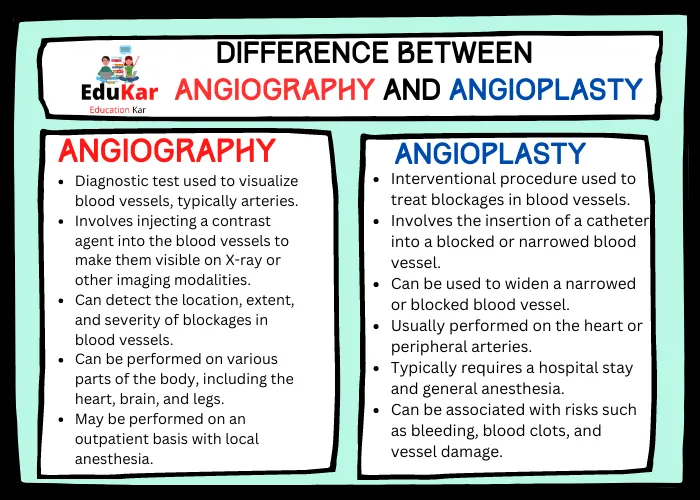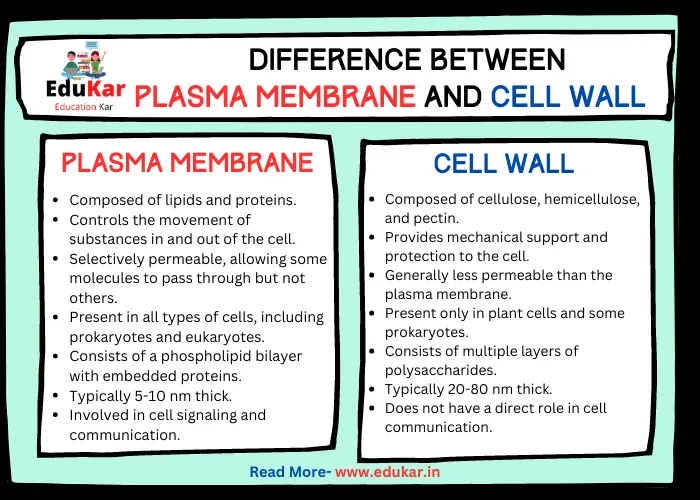Contents
- 1 Angiography
- 2 Angioplasty
- 3 Difference between Angiography and Angioplasty
- 4 Summary
- 5 FAQs
- 5.1 What is angiography?
- 5.2 What is angioplasty?
- 5.3 What is the main difference between angiography and angioplasty?
- 5.4 How is angiography performed?
- 5.5 How is angioplasty performed?
- 5.6 Is angiography painful?
- 5.7 Is angioplasty painful?
- 5.8 Are there any risks associated with angiography or angioplasty?
Learn about the key differences between angiography and angioplasty. We have described everything about what each procedure involves, how they are performed, and the potential risks associated with them.
Angiography and angioplasty are two procedures that are commonly used to diagnose and treat heart and blood vessel problems. It is essential to understand the difference between these procedures to make informed decisions about medical care.

Angiography
Angiography is a diagnostic tool that is used to visualize blood vessels in the body, particularly the heart’s arteries. The procedure involves injecting a special dye into the blood vessels to help the arteries show up on X-rays. The dye, called contrast material, is usually injected into the bloodstream through a catheter, which is a small, flexible tube inserted through an artery in the groin or arm.
Procedure and preparation
Before the procedure, the patient will be given sedatives to help them relax. The area where the catheter will be inserted is numbed with a local anesthetic. The procedure typically takes about an hour to complete.
Risks and complications
The risks of angiography include bleeding, infection, and allergic reactions to the dye. After the procedure, the patient will be advised to drink plenty of fluids to help flush out the dye from the body. The patient will be closely monitored for several hours before being discharged.
Angioplasty
Angioplasty is a treatment for blocked or narrowed arteries. The procedure involves inserting a catheter with a small balloon at the end into the blocked artery. The balloon is then inflated to widen the artery and improve blood flow. In some cases, a small metal mesh tube called a stent may be placed in the artery to help keep it open.
Also Read: Difference Between Meristematic Tissue and Permanent Tissue
Procedure and preparation
Before the procedure, the patient will be given local anesthesia to numb the area where the catheter will be inserted. The procedure typically takes about an hour to complete.
Risks and complications
The risks of angioplasty include bleeding, infection, damage to the artery, and allergic reactions to the dye. After the procedure, the patient will be closely monitored for several hours before being discharged. Patients may be prescribed medication to help prevent blood clots and reduce the risk of complications.
Difference between Angiography and Angioplasty
| Angiography | Angioplasty |
|---|---|
| Diagnostic test used to visualize blood vessels, typically arteries | Interventional procedure used to treat blockages in blood vessels |
| Involves injecting a contrast agent into the blood vessels to make them visible on X-ray or other imaging modalities | Involves the insertion of a catheter into a blocked or narrowed blood vessel |
| Can detect the location, extent, and severity of blockages in blood vessels | Can be used to widen a narrowed or blocked blood vessel |
| Can be performed on various parts of the body, including the heart, brain, and legs | Usually performed on the heart or peripheral arteries |
| May be performed on an outpatient basis with local anesthesia | Typically requires a hospital stay and general anesthesia |
| Generally considered a low-risk procedure with few complications | Can be associated with risks such as bleeding, blood clots, and vessel damage |
| Can help guide treatment decisions for conditions such as coronary artery disease, peripheral artery disease, and aneurysms | May be used to relieve symptoms such as chest pain, shortness of breath, or leg pain |
| Usually takes 30 minutes to an hour to complete | Can take several hours to complete |
| Patients may experience some discomfort during the procedure, such as a warm sensation or a metallic taste in the mouth | Patients may experience some pain or discomfort at the catheter insertion site after the procedure |
| Rarely requires additional treatment or intervention | May require additional procedures, such as stenting, to maintain vessel patency over time |
Summary
Angiography and Angioplasty are two procedures used to diagnose and treat heart and blood vessel problems. Angiography is a diagnostic tool that involves injecting dye into the bloodstream to visualize blood vessels. Angioplasty is a treatment for blocked or narrowed arteries.
Angiography is generally less invasive and has fewer risks than angioplasty. It is important to consult with a healthcare provider to determine the best course of treatment for a specific condition.
Also Read: Difference Between Dominant and Recessive Traits
FAQs
What is angiography?
Angiography is a medical imaging procedure that uses X-rays and contrast dye to examine the blood vessels in various parts of the body.
What is angioplasty?
Angioplasty is a medical procedure that is used to treat narrow or blocked blood vessels by widening them using a balloon catheter.
What is the main difference between angiography and angioplasty?
The main difference between angiography and angioplasty is that angiography is a diagnostic procedure used to visualize blood vessels and identify blockages, while angioplasty is a therapeutic procedure used to treat blockages by widening the affected blood vessels.
How is angiography performed?
Angiography is performed by injecting a contrast dye into a blood vessel and then taking X-rays of the area of interest.
How is angioplasty performed?
Angioplasty is performed by threading a balloon catheter through a blood vessel to the site of the blockage, inflating the balloon to widen the vessel, and then removing the catheter.
Is angiography painful?
The injection of the contrast dye during angiography may cause a brief sensation of warmth or discomfort, but the procedure is generally not painful.
Is angioplasty painful?
Patients undergoing angioplasty are typically given local anesthesia to numb the area where the catheter is inserted, so they may experience some discomfort during the procedure, but it is not usually painful.
Are there any risks associated with angiography or angioplasty?
Both procedures carry a small risk of complications, including bleeding, infection, allergic reaction to the contrast dye, and damage to the blood vessel being treated. However, these risks are generally considered low, and most patients experience no complications.
















